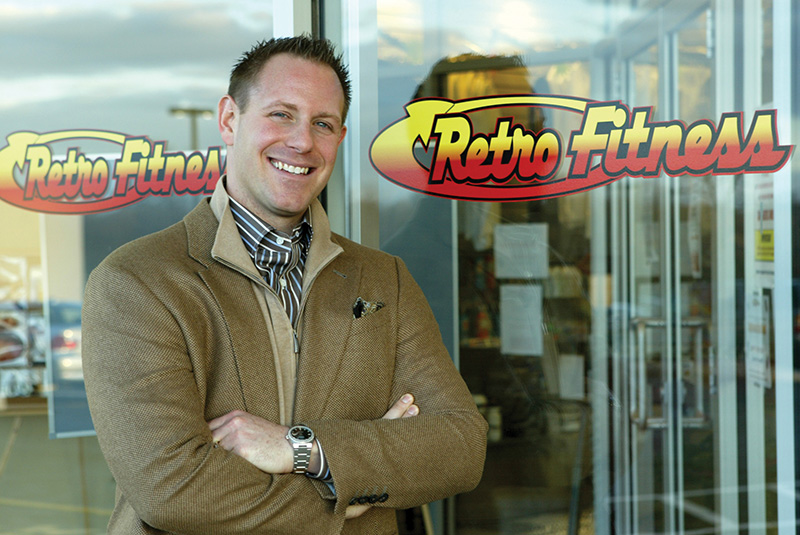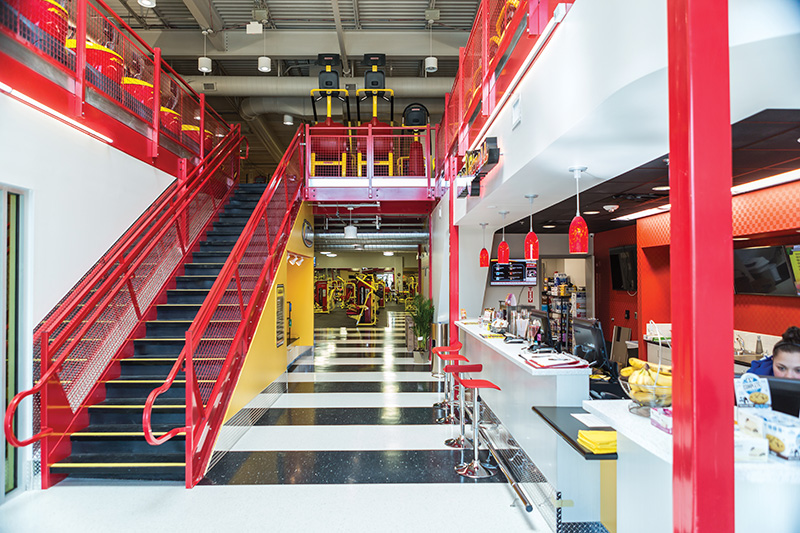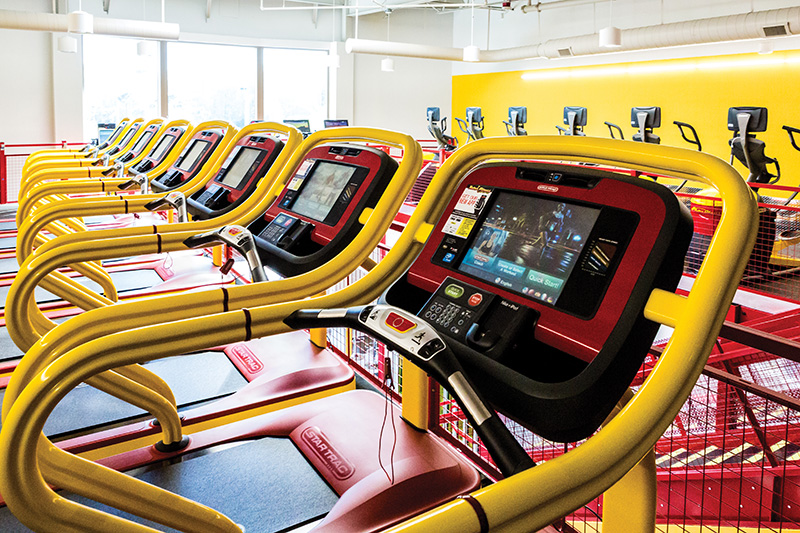Retro Fitness goes back to the future in elevating the customer experience and back to the basics for its all-important facility maintenance.
By Brian A. Lee
In the fitness industry, what does the body good does the business good as well. A business’ health, whether a gym or not, depends on the facility’s fitness and no maintenance can be too careful.
“The thing you’ve got to remember about franchisees: you’re essentially putting your baby in someone else’s hands,” says Eric Casaburi, founder and CEO of Retro Fitness, which has more than 135 locations across 16 states. “I’m giving it to you to benefit from, but I still want you to maintain my child.”
 Like the rigorous workouts of its dedicated customers, the Colts Neck, New Jersey-based fitness company has a precise, time-tested plan or protocol for its service vendors. As one might expect from a growing company that for five consecutive years has made the top 300 of Entrepreneur magazine’s prestigious Franchise 500 list, the maintenance protocol is meticulous and constantly evaluated through a thorough auditing process.
Like the rigorous workouts of its dedicated customers, the Colts Neck, New Jersey-based fitness company has a precise, time-tested plan or protocol for its service vendors. As one might expect from a growing company that for five consecutive years has made the top 300 of Entrepreneur magazine’s prestigious Franchise 500 list, the maintenance protocol is meticulous and constantly evaluated through a thorough auditing process.
And being in the fitness industry versus traditional retail means there are even more support needs.
“Maintaining our equipment — we’ve got a huge variety including about 80 pieces of cardio — is such an important aspect of how we do business,” Casaburi says. “It’s like going to a hotel and the bed springs are broken. If the equipment’s not working in a gym, that’s a problem. So we’re big on equipment maintenance.”
Retro Fitness’ facilities pros assess vendors by how long they have been in business, what their referral looks like, the other clients they have served and more. “We’ve got a huge ‘introduction to new vendor’ policy that they have to abide by,” Casaburi adds.
 The increased importance of proper air distribution, the higher amount of foot traffic and the contact-intensive nature of the business (see fitness equipment) make Retro Fitness’ maintenance needs quite unique from, say, your garden-variety dollar store.
The increased importance of proper air distribution, the higher amount of foot traffic and the contact-intensive nature of the business (see fitness equipment) make Retro Fitness’ maintenance needs quite unique from, say, your garden-variety dollar store.
“Managing your facility maintenance is a struggle,” says the Retro CEO, who notes that the company’s focus on efficiency includes “green” features such as LED lighting, accelerated hand-dryers, tank-less urinals and the like. “That’s why we usually have somebody walking the floor checking off things, wiping stuff down, keeping it clean. It’s important.”
Physical Growth
Retro Fitness has a lot of heavy lifting to do in the next 2 years. The company will rely on more than just adrenaline in implementing an ambitious growth strategy, which aims to move from its current annual level of around 30 new gym openings to triple digits.
 “We’ve really got to crush it next year and the year after,“ Casaburi says. “We’ve got to get to the point where we’re getting 100, 115 [new locations] a year. That’s the next stage. It’s how franchising growth really happens — exponentially. It’s really amazing how the growth happens in franchising, as opposed to doing corporate stores.”
“We’ve really got to crush it next year and the year after,“ Casaburi says. “We’ve got to get to the point where we’re getting 100, 115 [new locations] a year. That’s the next stage. It’s how franchising growth really happens — exponentially. It’s really amazing how the growth happens in franchising, as opposed to doing corporate stores.”
The Retro CEO projects 40 to 50 new locations in 2016, citing “a very aggressive growth plan, especially down in Orlando.” The company’s Northeast strongholds of Pennsylvania, New York and New Jersey continue to show solid growth. “With almost 70 gyms in New Jersey alone, we have a really amazing footprint in the whole state,” says Casaburi, who opened his first Garden State gym in Monmouth County in 2004.
Retro Fitness’ real estate site selection formula focuses on accessibility, whether freestanding locations or within power centers. Customers desire a gym near work or home, and fitness chains naturally aren’t as concerned about retail foot traffic.
“It can be the greatest foot traffic plaza with the highest gross sales for a retailer, but be the worst experience for us,” Casaburi says. “We’d rather go to a B center where people can get to it, and they love us for it.”
More to Offer — And Maintain
How ‘bout a gym that combines “go time” with show time? Retro Fitness has movie theaters inside all of its fitness centers.
“Although we’re a low-cost provider, you don’t get a low-cost experience,” says Casaburi. “That’s one of the things that I’ve spent so much time and energy on: how do we get the $100-a-month club experience but it only costs 19 bucks so that everyone can enjoy it?”
There’s nothing retro about the fitness machinery and systems at the 10-year-old chain. In fact, “really cool technology” comes standard, including mobile apps so gym-goers can track their progress or even compete against other members. Retro’s forward thinking mixes old-fashioned hard work and high tech to maximize the member’s experience.
“I enjoy doing things to bring the latest and the greatest into our clubs,” Casaburi says. “Constantly over-delivering on the promise of $19 [per month] and really exceeding their expectations — we do a really good job of it. And we don’t stop. We’re workout-aholics.”
 Retro Fitness’ footprint has evolved from 10,000 to 12,000 square feet at its inception to between 15,000 to 18,000 now. All new gyms in the hot Orlando market are 20,000 square feet or bigger.
Retro Fitness’ footprint has evolved from 10,000 to 12,000 square feet at its inception to between 15,000 to 18,000 now. All new gyms in the hot Orlando market are 20,000 square feet or bigger.
Casaburi says, “They are growing because we’re adding open turf areas, open group training areas where we can push a sled, do barrel loops, have sprints go on, have barre classes, etc. We’ve got this new component. We need more open space than we used to have, as opposed to having machines and treadmills.”
The “workout-aholic” mentality also applies to maximizing design and operational efficiencies. The Retro Fitness model is constantly evolving, according to Casaburi. In the last 2 years, Retro Fitness has partnered with Montclair, New Jersey-based Fabiano Designs, a full-service architecture and design firm with more than 20 years of experience in the fitness and wellness industries.
“Since it’s a franchise system, when they brought Fabiano Designs on, one of our goals was to create an interior design process and prototype at a certain cost,” says Rudy Fabiano, the firm’s founder. “Secondly, it had to be easy to maintain and look good over the whole period of ownership. A low-cost fitness center typically needs three times the membership base to meet its business model, so the trick is to have materials that are durable with a lot of people moving through it.”
Casaburi adds, “We’re constantly working to see how we can improve the value once you get in the box, as well as make it a really cool-looking customer experience, and a cool feeling that you get.”
Retro Fitness’ biggest operational and maintenance challenges are always mechanical: the power and HVAC. A landlord accustomed to regular retailers often times does not realize the far greater power requirements of a fitness center tenant.
“We need more [HVAC] — 1 ton per 250 square feet as opposed to 1 ton per 400 square feet or whatever the [conventional] retailers need,” Casaburi says. “Sometimes it’s hard to get our retail landlord to understand our power needs if they’ve never dealt with it before.”
Parking conditions within leases can be another sticking point. Retro Fitness gyms don’t pack the parking lots like the old-school facilities would with their large aerobic classes. The company has had to convince the Publixes and Rosses of the retail world to do away with the co-tenant parking exclusion conditions regarding gyms in their leases. According to Casaburi, it took some convincing but Bed Bath & Beyond eased up on its parking exclusion restrictions and is glad it did. The domestic merchandise retailer allowed Retro Fitness as a co-tenant and saw its sales go from the bottom third of the chain’s area stores to the “top of the top third” the following year.
“We’re phenomenal tenants; we drive traffic,” Casaburi says. “During the recession, we were rock stars. Back in the 1990s, gyms had a bad rap as a co-tenant. It’s a totally different world with our type of fitness center. We’re an evolved model.”
It’s quite evident that Retro Fitness’ leader is fueled by growth — business by business, corporate to franchisees and especially in personal development. Casaburi has certainly chosen the right line of work, the personal satisfaction going far beyond a customer reaching their weight loss objective or bench press goal.
“I love watching people learn how to be an entrepreneur,” he says. “I get to see the fruits of my labor, I get to see franchisees and how their families have grown. I tell franchisees whatever you did in sales today helped somebody: helped them live healthier, feel better, look better, improve their lives, relieve depression, all the things that fitness can give. We sell a really awesome product. I’ve been recruited by other top firms to come run their companies, but none of them have the reward that fitness does — knowing that every day we’re doing something good for a lot of people.”
The passion for people and “workout-aholic” approach is, well, certainly working out. With more than 100 gyms in the development pipeline and plans to open 200 locations in the next 2 years, many more are ready to go Retro.
— Brian A. Lee is a freelance reporter who has covered all sectors of real estate since 2000. He was a commercial real estate magazine editor for 8 years.Email the author at [email protected].
